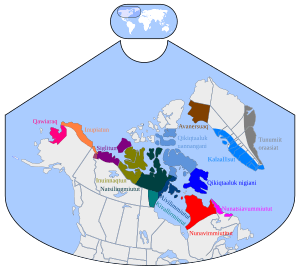Inuktun facts for kids
Quick facts for kids Inuktun |
||||
|---|---|---|---|---|
| Polar Inuit avanersuarmiutut |
||||
| Native to | Greenland Kingdom of Denmark |
|||
| Region | Avanersuaq | |||
| Ethnicity | Inughuit | |||
| Native speakers | (800–1,000 cited 1995) | |||
| Language family |
Eskimo–Aleut
|
|||
| Official status | ||||
| Official language in | Greenland | |||

Inuit dialects. Inuktun is the brown area ("Avanersuaq") in the northwest of Greenland.
|
||||

|
||||
|
||||
Inuktun is a special language spoken by about 1,000 Inughuit people. These people are also known as Polar Inuit. They live in the northernmost towns and villages of Greenland, like Qaanaaq.
Contents
Where Inuktun is Spoken
Inuktun is mainly spoken in the town of Qaanaaq. But it's also used in several nearby villages. These villages include Moriusaq (called Muriuhaq in Inuktun), Siorapaluk (Hiurapaluk), Qeqertat (Qikiqtat), Qeqertarsuaq (Qikiqtarhuaq), and Savissivik (Havighivik).
What Kind of Language is Inuktun?
Inuktun belongs to a group of languages called Eskimo–Aleut languages. It's like a bridge between the main Greenlandic language (Kalaallisut) and the Inuktitut language spoken in Canada. Inuktun has some unique sounds, grammar rules, and words that make it different from Kalaallisut.
The Story of Inuktun
The Inughuit people, who speak Inuktun, were the last group to travel from Canada to Greenland. They might have arrived as recently as the 1700s. The first people to write about Inuktun were explorers Knud Rasmussen and Peter Freuchen. They explored northern Greenland in the early 1900s. In 1910, they even set up a trading post near Pituffik.
Inuktun Today
Inuktun doesn't have its own official writing system. It's also not taught in schools. However, most people in Qaanaaq and the nearby villages use Inuktun every day. It's their main language for talking with family and friends.
Most Inuktun speakers also know Standard Greenlandic. Many can speak Danish, and some even speak English.
How Inuktun Sounds
Even though Inuktun doesn't have an official writing system, linguists (people who study languages) have found ways to write down its sounds. The way Inuktun sounds is similar to other Inuit languages. It has three main vowel sounds, like the "ee" in "see," the "oo" in "moon," and the "ah" in "father."
One interesting difference from Standard Greenlandic is how some "s" sounds are pronounced. In Inuktun, they often sound more like an "h." Inuktun also has more ways to combine consonant sounds than Standard Greenlandic. This means some words might sound a bit different when spoken.

